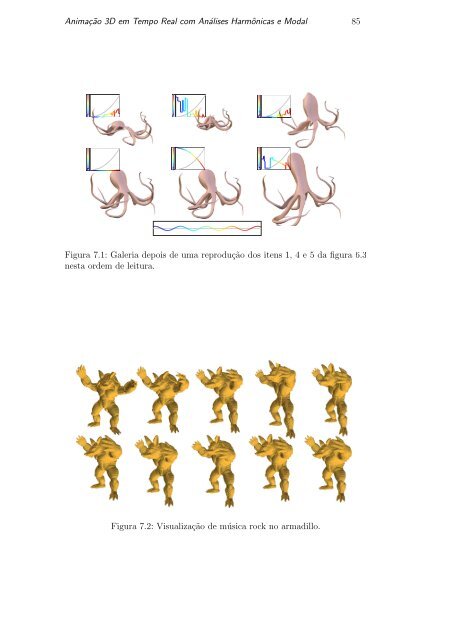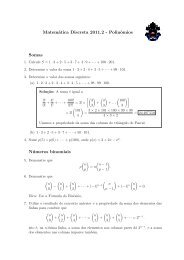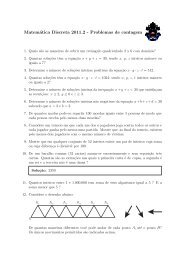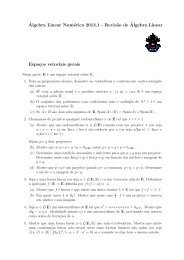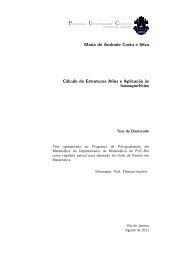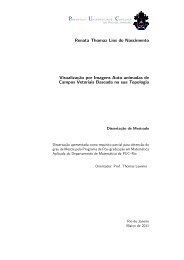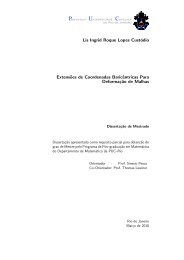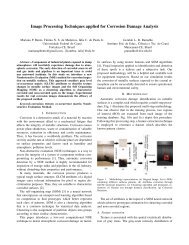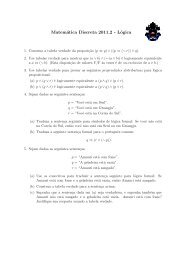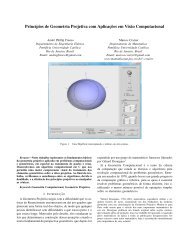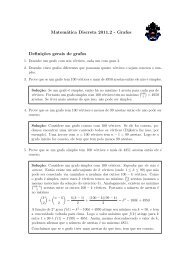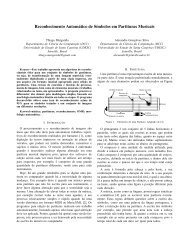Clarissa Codá dos Santos Cavalcanti Marques Animaç ... - PUC-Rio
Clarissa Codá dos Santos Cavalcanti Marques Animaç ... - PUC-Rio
Clarissa Codá dos Santos Cavalcanti Marques Animaç ... - PUC-Rio
Create successful ePaper yourself
Turn your PDF publications into a flip-book with our unique Google optimized e-Paper software.
Animação 3D em Tempo Real com Análises Harmônicas e Modal 85Fig. 5.Gallery after one reproduction from the 1 st , 4 th and 5 th items of Fig. 3 in reading order, with the reproduced transfer and amplification functions.Figura 7.1: Galeria depois de uma reprodução <strong>dos</strong> itens 1, 4 e 5 da figura 6.3nesta ordem de leitura.B. Tuning through design galleriesThe filter design above gives a concise representation of theof the pair using a 1 2-Bernoulli trial (“heads or tails”). Wedecide in a similar manner if the amplification functions willharmonic mapping t,a from sound harmonic amplitudes to be combined.manifold harmonic amplitudes. Indeed t,a is represented as The combination of the frequency transfer functions t 0two vectors: t 2 N #! is an integer vector of size #!, and a 2 and t 00 of the pair is done as follow. First we randomlyR #k is a real vector of size #k. This allows to easily mix twoharmonic mappings by combinations of those vectors. Usingvocabulary from genetic algorithms, the harmonic mappingchoose an integer value n 0 k , as a geometric random variable in{1,...#k}, and a random real value w 0 uniformly in [0, 1].We then set the first n 0 k coefficients of vector t as the firstt,a is represented by two chromosomes a and t, which can n 0 k coefficients of w0 · t 0 +(1 w 0 ) · t 00 . We choose againreproduce by combination.This leads to a direct design gallery interface, where differentharmonic mappings are proposed to the user, who canselect the ones he likes. From this selection, a new gallery isgenerated using genetic reproduction, until the user choosesonly one harmonic mapping, as explained in the next section.The following section will detail the initial gallery creation.The harmonic mapping can then be directly edited from thetwo curves of t and a.random values n 1 k 2{1,...#k} and w1 2 [0, 1], and clampn 1 k to ensure n0 k + n1 k apple #k (the geometric random processintends to reduce the effect of this clamping). We then set thefollowing n 1 k values of t as above, and repeat until completingall the frequencies. We perform the same operations for theamplifications (see Figs. 3 and 5).This combination method avoids producing combinationthat varies too quickly, as compared to randomly choosingreal values w at each frequency.C. ReproductionThe reproduction generates a new gallery of S harmonicmappings from a selection of old mappings. To do so, S pairsof distinct selected old mappings are randomly chosen. Eachpair is then combined into a new mapping as follows.Since the frequency transfer and amplification functionst and a have complementary effects, we reproduce themindependently. This also reduces the initial gallery size, asexplained in the next subsection. In practice, this means thatwe first decide if we combine the frequency transfer functionsD. Gallery initializationWe generate an initial gallery (see Fig. 3) that couldtheoretically generate any harmonic mapping by the abovereproduction. Since the reproduction of the frequency transferand amplification are independent, we can use the S elementsof the initial gallery to span the frequency transfer functionsand the same S elements to span the amplification functions.This reduces the size of the initial gallery, although it generallyrequires one more reproduction to get interesting mappings.Fig. 11.REFERENCES[1] B. Vallet and B. Lévy, “Spectral geometry processing with manifoldharmonics,” in Computer Graphics Forum, vol. 27, no. 2, 2008, pp.251–260.[2] F. de Moura Pinto and C. M. D. S. Freitas, “Two-level interaction transferfunction design combining boundary emphasis, manual specificationand evolutive generation,” in Sibgrapi. IEEE, 2006, pp. 281–288.[3] A. Bordignon, L. Sigaud, G. Tavares, H. Lopes, T. Lewiner, andW. Morgado, “Arch generated shear bands in granular systems,” PhysicaA: Statistical Mechanics and its Applications, vol. 388, no. 11, pp. 2099– 2108, 2009.[4] H. Jenny, Cymatics: A Study of Wave Phenomena & Vibration, 3rd ed.Macromedia, 2001.[5] R. W. Clough and J. Penzien, Dynamics of Structures. Mcgraw-Hill,1975.[6] A. Pentland and J. Williams, “Good vibrations: modal dynamics forgraphics and animation,” Siggraph, vol. 23, no. 3, pp. 207–214, 1989.[7] C. Yinghui, W. Jing, and L. Xiaohui, “Real-time deformation usingmodal analysis on graphics hardware,” in Graphite. ACM, 2006, pp.173–176.[8] J. F. O’Brien, C. Shen, and C. M. Gatchalian, “Synthesizing soundsFrames of rock music visualization using the armadillo model.Figura 7.2: Visualização de música rock no armadillo.[13] K. Wang, M. Luo, A. Bors, and F. Denis, “Blind and robust meshwatermarking using manifold harmonics,” in ICIP. IEEE, 2009, pp.3657–3660.[14] M. Ovsjanikov, J. Sun, and L. Guibas, “Global intrinsic symmetries ofshapes,” in SGP. Eurographics, 2008, pp. 1341–1348.[15] H.-Y. Wu, T. Luo, L. Wang, X.-L. Wang, and H. Zha, “3D shape retrievalby using manifold harmonics analysis with an augmentedly local featurerepresentation,” in VRCAI. ACM, 2009, pp. 311–313.[16] J. Marks, B. Andalman, P. Beardsley, W. Freeman, S. Gibson, J. Hodgins,T. Kang, B. Mirtich, H. Pfister, W. Ruml et al., “Design galleries:A general approach to setting parameters for computer graphics andanimation,” in Siggraph. ACM, 1997, p. 400.[17] “The OpenGL Shading Language v 4.0,” 2010, www.opengl.org/ documentation/glsl.[18] Apple, “PBORenderToVertexArray: render-to-vertex-array using FBO,PBO and VBO,” 2006, developer.apple.com/ mac/ library/ samplecode/PBORenderToVertexArray.[19] F. Patin, “Beat detection algorithms,” 2003, www.gamedev.net/ reference/programming/ features/ beatdetection.[20] V. Hernandez, J. Roman, and V. Vidal, “SLEPc: A scalable and flexibletoolkit for the solution of eigenvalue problems,” Transactions onMathematical Software, vol. 31, no. 3, p. 362, 2005.


